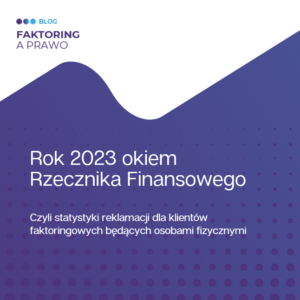On January 17, 2019. The Polish Institute of Credit Management held a video-webinar "European Distribution Fraud - examples, mechanism, counteraction". The full transcript of the webinar is available on YT here. As I was a participant in the aforementioned webinar, I decided to summarize for you the most important information from the webinar and translate it into factoring and the risks inherent in this industry.
Distribution fraud involves the theft of the identity of a known company by fraudsters impersonating it, with the aim of defrauding it of goods (without prepayment, under so-called trade credit). This scam is already quite well-known, especially among insurers, as it has been operating since at least 2010. It is characterized by almost zero detection of perpetrators.
What is the standard mechanism of distribution fraud?
- Victims. Victims of the scam are companies exporting goods (from various European countries, including Poland) that make sales on a trade credit basis also to new customers, regardless of whether they use receivables insurance on such transactions;
- Industries at risk. The most fraud-prone industries are fast-moving goods: electronics, clothing, food products, raw materials, chemicals;
- Identity theft. Scammers impersonate reputable, well-known companies whose branding impresses victims. These are usually well-known retail chains from the UK, France, Italy - such as, for example, ASDA, Tesco, Aldi, Waitrose, Morrison's, John Lewis, Lidl, Sainsbury's, Iceland, Multi Cash, Marks & Spencer, Leroy Merlin, etc. This choice of company is meant to lull the victim's vigilance somewhat. The intention of the scammers is, on the one hand, to spread over the victim the vision of a multi-year sale with a large buyer, and, on the other hand, to impersonate an entity that, if anything, will pass the examination of financial capacity for trade credit without generating direct contact. In the case of large reputable companies (often listed on stock exchanges) - their financial results are generally available online, which does not require direct contact with the insurer when granting a limit. In addition, these companies are often known to insurers by virtue of their regular auditing;
- Contact. The scammers most often get in touch with the victim either by email/online or in person, e.g. at an industry trade show, introducing themselves as a purchasing agent. More often than not, they quickly move on to a direct, even friendly relationship. They introduce themselves as directors of purchasing departments and sometimes even members of the management, board of directors;
- Emails. Scammers write e-mails from addresses in domains very similar to the original ones, with minor changes (e.g., instead of nestle.com - netsle.com, or nestle-supply.com, or in national domains - e.g., netsle.uk, or in free domains, e.g., nestle.supply[at]gmail.com). They also often create bogus websites with false contact information;
- Order. Once they make contact, they place an order for goods with a value most often around €50,000-150,000 (this value of goods is both profitable and realistic). They rarely negotiate the price, and do not pay attention to important legal issues such as labels in the country of sale (e.g., a company from the UK orders goods with labels without English);
- Documents. In the case of investigating the financial situation of the contracting authority, the fraudsters send all the necessary documents, have all the powers of attorney, stamps, etc. They arrange every necessary signature of the board of directors at a fast pace, which is unrealistic under market conditions. They send orders with stamps and board signatures which is unheard of in EU countries;
- Delivery address. Initially, the real headquarters/branch of the company is indicated as the delivery address. Only later do the scammers change the delivery address at the last minute (sometimes even several hours before delivery) citing made-up reasons - e.g. road closures, unloading ramp failure, etc., directing the delivery, as a rule, to shared warehouses located not far from the real headquarters;
- After delivery of the goods, the goods quickly disappear and the scammer is lost, sometimes maintaining contact only to lull vigilance, or trying to "follow the blow" and immediately make a scam of another batch by reporting great sales of products. The goods are in fact illegally sold, often in the gray market;
- Elusiveness. With a scam structured in this way, fraudsters are virtually elusive. Prosecution is made much more difficult by the cross-border nature of these cases. A great many companies from Poland, but also from other EU countries, have already been defrauded in this way, causing multimillion-dollar losses.
- Insurance Trade credit does not cover such events, as there is no real sales transaction - after all, the fraudsters impersonate the company acting as false agents. The receivable remains disputed and cannot be enforced against the real company impersonated by the fraudsters;
- How to counteract? More carefully verify new customers, their identities, addresses, comparing actual data, paying attention to the aforementioned signals, not sending goods on trade credit for new companies, requiring prepayment. Verify company addresses (Google Maps/Street View), contacts on linkedIN, apply and co-create own risk procedures within the compliance system.
- Distribution fraud vs. FACTORING
First, the factoring company can fall victim to such fraud on a new counterparty not reported for factoring, which can wreak havoc on its liquidity, which ultimately can also affect the previously well-performing factoring company, and in extreme cases lead to the factoring company's bankruptcy.
Secondly, there is the risk that the factor will bring a new recipient to the factor by reporting it for factoring, which recipient is supposed to be a well-known company, and this one is really an impostor. Then all documents, statements and signatures will be obtained by this fraudster. In the age of online factoring, this does not always have to be caught already before the start of financing. In classic factoring it should be caught at the stage of verification of turnover, the history of which simply will not be here. The situation is unlikely, but not impossible. After all, it does not have to differ much from the situation in which the factor would independently report such a recipient to trade credit insurance. Depending on the standards and procedures of the factoring company in question, there may also be a risk of recipient impersonation fraud here. Factoring companies using "single invoice factoring," which do not require a history of turnover and have loose criteria for accepting a recipient, seem to be most vulnerable to it. If a factoring company grants a factoring limit on such a recipient, then after the fraud comes to light, the only entity liable will be the factoring company itself under recourse. This is because the claim submitted for factoring will be fictitious. Thus, in the best case, the factor will regress the factor, and in the worst case it will get into a dispute with the factor and end the cooperation.
So how can the factor defend itself here? Among other things, by direct contact with the notified recipient to the contact information provided on the recipient's real website (and not to fictitious information provided by fraudsters). The key will be to contact the recipient's real accounting and/or purchasing department. Then the fraud should come to light. For new recipients submitted for factoring, it is always advisable to establish telephone contact through the company's call center, i.e., a confirmed and reliable number, not a cell phone.
I encourage you to discuss and share your experiences in the above-mentioned area.
I also encourage you to take a look at an article on factoring fraud mechanisms.







